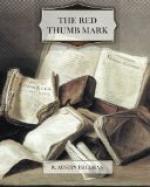“Now it has been proved by exact calculations—which calculations I have personally verified—–that the chance that the print of a single finger of any given person will be exactly like the print of the same finger of any other given person is as one to sixty-four thousand millions. That is to say that, since the number of the entire human race is about sixteen thousand millions, the chance is about one to four that the print of a single finger of any one person will be identical with that of the same finger of any other member of the human race.
“It has been said by a great authority—and I entirely agree with the statement—that a complete, or nearly complete, accordance between two prints of a single finger affords evidence requiring no corroboration that the persons from whom they were made are the same.
“Now, these calculations apply to the prints of ordinary and normal fingers or thumbs. But the thumb from which these prints were taken is not ordinary or normal. There is upon it a deep but clean linear scar—the scar of an old incised wound—and this scar passes across the pattern of the ridges, intersecting the latter at certain places and disturbing their continuity at others. Now this very characteristic scar is an additional feature, having a set of chances of its own. So that we have to consider not only the chance that the print of the prisoner’s left thumb should be identical with the print of some other person’s left thumb—which is as one to sixty-four thousand millions—but the further chance that these two identical thumb-prints should be traversed by the impression of a scar identical in size and appearance, and intersecting the ridges at exactly the same places and producing failures of continuity in the ridges of exactly the same character. But these two chances, multiplied into one another, yield an ultimate chance of about one to four thousand trillions that the prisoner’s left thumb will exactly resemble the print of some other person’s thumb, both as to the pattern and the scar which crosses the pattern; in other words such a coincidence is an utter impossibility.”
Sir Hector Trumpler took off his glasses and looked long and steadily at the jury as though he should say, “Come, my friends; what do you think of that?” Then he sat down with a jerk and turned towards Anstey and Thorndyke with a look of triumph.
“Do you propose to cross-examine the witness?” inquired the judge, seeing that the counsel for the defence made no sign.
“No, my lord,” replied Anstey.
Thereupon Sir Hector Trumpler turned once more towards the defending counsel, and his broad, red face was illumined by a smile of deep satisfaction. That smile was reflected on the face of Mr. Singleton as he stepped from the box, and, as I glanced at Thorndyke, I seemed to detect, for a single instant, on his calm and immovable countenance, the faintest shadow of a smile.
“Herbert John Nash!”




